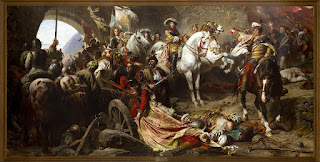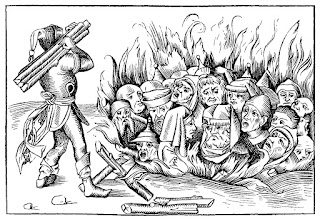Dead Bodies in the Buda Synagogue, 1686
Buda, Hungary
2 September, 1686
The Buda synagogue was constructed in 1461. Buda was a hotspot for the confrontation between Christians and the Ottoman Empire. The city was captured by the Ottomans in 1526 (who banished and then re-welcomed the Jews) and retaken by the Christians in 1686.
When the Christians entered the city in 1686, they began a widespread slaughter of all the residents. The Jews of the town ran into the synagogue for protection, but the Hapsburg troops battered their way in and killed everyone inside. Only Rabbi Isaac Schulhof was released and he eventually wrote a first-hand account of the attack, Megilat Ofen. The building was torched, with the bodies left inside to rot.
Hundred of Jews from the town were captured and held for ransom, including Schulhof. Eventually Samuel Oppenheimer, the Hapsburg Emperor's banker, redeemed them. (The Holocaust and the Book: Destruction and Preservation, 269)
In was three hundred years later, in 1964, when the ruins of the synagogue were uncovered. 72 bodies lay inside, including one wearing tefillin.
The building has since been restored and today serves as a small museum. (Medieval Hungary and Schulhof Foundation)
2 September, 1686
The Buda synagogue was constructed in 1461. Buda was a hotspot for the confrontation between Christians and the Ottoman Empire. The city was captured by the Ottomans in 1526 (who banished and then re-welcomed the Jews) and retaken by the Christians in 1686.
When the Christians entered the city in 1686, they began a widespread slaughter of all the residents. The Jews of the town ran into the synagogue for protection, but the Hapsburg troops battered their way in and killed everyone inside. Only Rabbi Isaac Schulhof was released and he eventually wrote a first-hand account of the attack, Megilat Ofen. The building was torched, with the bodies left inside to rot.
Hundred of Jews from the town were captured and held for ransom, including Schulhof. Eventually Samuel Oppenheimer, the Hapsburg Emperor's banker, redeemed them. (The Holocaust and the Book: Destruction and Preservation, 269)
In was three hundred years later, in 1964, when the ruins of the synagogue were uncovered. 72 bodies lay inside, including one wearing tefillin.
The building has since been restored and today serves as a small museum. (Medieval Hungary and Schulhof Foundation)



Comments
Post a Comment